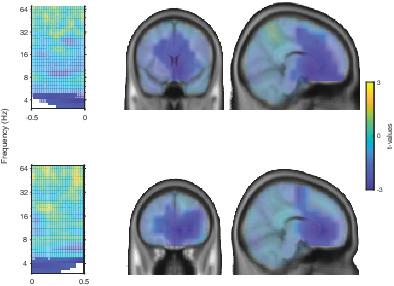当前位置:
X-MOL 学术
›
Hum. Brain Mapp.
›
论文详情
Our official English website, www.x-mol.net, welcomes your
feedback! (Note: you will need to create a separate account there.)
Mediofrontal theta‐band oscillations reflect top‐down influence in the ventriloquist illusion
Human Brain Mapping ( IF 3.5 ) Pub Date : 2020-10-14 , DOI: 10.1002/hbm.25236 Mathis Kaiser 1, 2 , Daniel Senkowski 1 , Julian Keil 1, 3
Human Brain Mapping ( IF 3.5 ) Pub Date : 2020-10-14 , DOI: 10.1002/hbm.25236 Mathis Kaiser 1, 2 , Daniel Senkowski 1 , Julian Keil 1, 3
Affiliation

|
In the ventriloquist illusion, spatially disparate visual signals can influence the perceived location of simultaneous sounds. Previous studies have shown asymmetrical responses in auditory cortical regions following perceived peripheral sound shifts. Moreover, higher‐order cortical areas perform inferences on the sources of disparate audiovisual signals. Recent studies have also highlighted top‐down influence in the ventriloquist illusion and postulated a governing function of neural oscillations for crossmodal processing. In this EEG study, we analyzed source‐reconstructed neural oscillations to address the question of whether perceived sound shifts affect the laterality of auditory responses. Moreover, we investigated the modulation of neural oscillations related to the occurrence of the illusion more generally. With respect to the first question, we did not find evidence for significant changes in the laterality of auditory responses due to perceived sound shifts. However, we found a sustained reduction of mediofrontal theta‐band power starting prior to stimulus onset when participants perceived the illusion compared to when they did not perceive the illusion. We suggest that this effect reflects a state of diminished cognitive control, leading to reliance on more readily discriminable visual information and increased crossmodal influence. We conclude that mediofrontal theta‐band oscillations serve as a neural mechanism underlying top‐down modulation of crossmodal processing in the ventriloquist illusion.
中文翻译:

中额叶θ带振荡反映了口技错觉中自上而下的影响
在口技幻觉中,空间上不同的视觉信号可以影响同时声音的感知位置。先前的研究表明,听觉皮层区域在感知周围声音变化后会出现不对称反应。此外,高阶皮质区域对不同视听信号的来源进行推断。最近的研究还强调了口技幻觉中自上而下的影响,并假设了神经振荡对跨模态处理的控制功能。在这项脑电图研究中,我们分析了源重建的神经振荡,以解决感知声音变化是否影响听觉反应的偏侧性的问题。此外,我们更广泛地研究了与错觉发生相关的神经振荡的调节。关于第一个问题,我们没有发现由于感知到的声音变化而导致听觉反应的偏侧性发生显着变化的证据。然而,我们发现,与没有感知到幻觉时相比,当参与者感知到幻觉时,在刺激开始之前,中额叶θ带功率开始持续下降。我们认为这种效应反映了认知控制减弱的状态,导致对更容易辨别的视觉信息的依赖和跨模式影响的增加。我们得出的结论是,中额叶θ带振荡是腹语错觉中跨模态处理自上而下调制的神经机制。
更新日期:2020-10-14
中文翻译:

中额叶θ带振荡反映了口技错觉中自上而下的影响
在口技幻觉中,空间上不同的视觉信号可以影响同时声音的感知位置。先前的研究表明,听觉皮层区域在感知周围声音变化后会出现不对称反应。此外,高阶皮质区域对不同视听信号的来源进行推断。最近的研究还强调了口技幻觉中自上而下的影响,并假设了神经振荡对跨模态处理的控制功能。在这项脑电图研究中,我们分析了源重建的神经振荡,以解决感知声音变化是否影响听觉反应的偏侧性的问题。此外,我们更广泛地研究了与错觉发生相关的神经振荡的调节。关于第一个问题,我们没有发现由于感知到的声音变化而导致听觉反应的偏侧性发生显着变化的证据。然而,我们发现,与没有感知到幻觉时相比,当参与者感知到幻觉时,在刺激开始之前,中额叶θ带功率开始持续下降。我们认为这种效应反映了认知控制减弱的状态,导致对更容易辨别的视觉信息的依赖和跨模式影响的增加。我们得出的结论是,中额叶θ带振荡是腹语错觉中跨模态处理自上而下调制的神经机制。









































 京公网安备 11010802027423号
京公网安备 11010802027423号